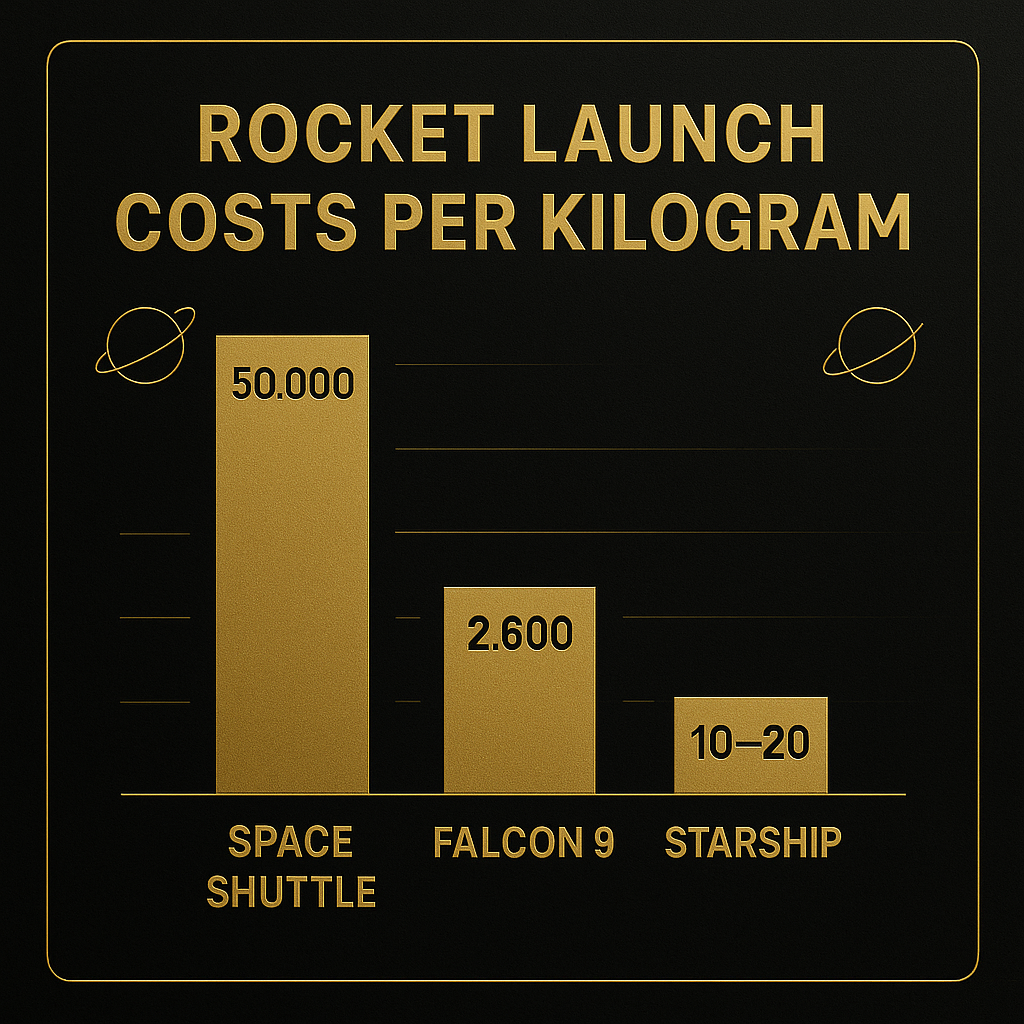Starship Basic Economics: The Wheel of Space
SpaceX’s Starship isn’t just a rocket. It’s a macroeconomic disruptor engineered to make space commercially inevitable. If the company’s cost targets are met — $10 million per launch and $10–20/kg to orbit — Starship could lower the barrier to space so dramatically that entire industries, once stranded on Earth by physics and finance, may lift off.
TLDR:
Starship’s total dev cost: estimated to be in the realm of $10 billion
Production per ship: Currently ~$100 million with target of ~$20 million
Reusability drops launch costs: From ~$100 million down to a targeted $10 million
Cost per kg to space: from current $2.5M/kg to immediate $250k/kg with goals to drop further to $250/kg with ultimate goal of $10-20/kg
Total payload: 150-250kg compared to Falcon 9’s 22kg
Future articles will explore the massive value potential this creates in other sectors
The $10 Billion Bet
Starship is an audacious bet, with an estimated $10 billion in total R&D costs 5. As of early 2024, SpaceX has reportedly invested around $8 billion 1, including the creation of Starbase in Boca Chica, Texas — a vertically integrated spaceport, factory, and laboratory.
To put that in context: NASA’s expendable Space Launch System has cost nearly $24 billion 1. Starship is targeting reusable orbital delivery at less than half the investment and with exponentially greater capacity.
Fueling the Future: How SpaceX Funds the Fire
SpaceX funds Starship development via a hybrid approach: internal revenue (Falcon 9, Dragon, Starlink), equity fundraising, and high-stakes partnerships like NASA’s Human Landing System contract. Capital is spread across engine development, manufacturing capacity, infrastructure, software, avionics, and recovery systems 2.
This isn’t CapEx for a single vehicle. It’s investment in a scalable launch economy.
Cost Per Vehicle
Today, each Starship system (booster + ship) is estimated to cost ~$90 million to build 4. But SpaceX forecasts this will drop sharply — possibly to $20 million with scale, and potentially as low as $2–5 million in the long term.
Such reductions would represent a Moore’s Law-like curve in aerospace hardware — once inconceivable in rocketry.
The Raptor Engine: A Cost Revolution in Itself
Each Raptor engine currently costs ~$1 million. With 39 Raptors on a full stack, propulsion alone runs ~$39 million 4. But that’s changing fast.
SpaceX’s Raptor factory is targeting 4,000 engines/year. Unit costs are already falling — aiming for $0.25–0.5 million per engine 4. That’s a fraction of the ~$20 million BE-4 engine from Blue Origin 1. It’s vertical integration at scale.
Cost Per Kilogram
In expendable configuration, Starship could achieve ~$150/kg to orbit 4. But with full reuse? SpaceX aims for $10–20/kg 4 — 98–99% cheaper than current norms.
The Marginal Model
Once reuse is functional, marginal launch costs could fall below 20% of build cost 4. Compare that to traditional rockets, which are destroyed every flight. It’s the difference between driving a car and building a new one every time you commute.
For Comparison: NASA’s SLS and Falcon 9 vs. Starship
SLS launches cost ~$2 billion — and every rocket is discarded 6. A mature Starship could be 200x cheaper per launch.
Even SpaceX’s own Falcon 9 — a partially reusable workhorse — costs $60 million per flight. It delivers ~22 tons to LEO. Starship could deliver 150–250 tons. That’s up to 11x the capacity at lower cost 4.
New Markets, New Models, New Growth
Starship’s enormous capacity and low-cost model unlocks non-traditional use cases across all industries:
Constellation Deployment: One Starship could launch over 50 next-gen Starlinks at once 3.
Satellite Design Renaissance: Mass and volume constraints are dramatically loosened — potentially cutting design, testing, and risk mitigation costs and increasing capabilities 3.
Space Infrastructure: Entire space stations, orbital fuel depots, and telescopes can be launched in one shot with increased dimensions and enhanced material build outs 3.
Space Industrials: With simultaneous advancements in Autonomous Vehicles, Robotics and Ai entire industries could start to transition to the benefits of zero gravity manufacturing and abundant rare earth resources located in the asteroid belt.
Space Services: One off services to support the deep tech renaissance and space gold rush will expand to aid in mission design and management.
We will start to evaluate the economic potential of each of these sectors and industries moving forward as they will have immediate impact on Earth while economies of scale plays out within the Starship program over time.
A Rocket as a Platform
Starship is less a vehicle than a platform — one that could make orbit an addressable market for industries far beyond aerospace. The $8+ billion invested so far 1 is just a mere down payment on a potential economic flywheel with global consequences.
If SpaceX can deliver orbital access for $10/kg 4, entire sectors — manufacturing, logistics, entertainment, energy, biology — could find viable business cases in orbit. But that future hinges on the ultimate execution of full reusability at industrial scale.
Until then, Starship remains the most expensive economic experiment in aerospace history. And possibly, its most transformative.
Disclaimer: The information provided is for informational and educational purposes only and should not be construed as financial, investment, tax, legal, or other professional advice. It does not constitute an offer to buy or sell any securities or a recommendation to engage in any investment strategy. All investments involve risks, including the potential loss of principal. Past performance is not indicative of future results. Opinions expressed are those of the authors or speakers and are subject to change without notice. You should consult a qualified financial advisor, accountant, or other professional before making any investment decisions. Space Investments and Co. and its affiliates are not responsible for any financial losses or damages resulting from the use of this information.
Citations:
https://www.modelrockets.us/how-much-does-the-starship-cost/
https://reason.org/commentary/nasa-should-consider-switching-to-spacex-starship-for-future-missions/
https://en.as.com/latest_news/how-much-money-does-elon-musks-spacex-starship-program-cost-n-2/
https://spaceambition.substack.com/p/the-starship-can-one-rocket-change
https://www.reddit.com/r/SpaceXLounge/comments/1g2vxz5/starshipsuper_heavy_fuel_cost/
https://spaceambition.substack.com/p/the-starship-can-one-rocket-change
https://ffg-forum-archive.entropicdreams.com/topic/89479-starship-equipment-and-operating-costs/
https://www.modelrockets.us/how-much-does-the-starship-cost/
https://www.reddit.com/r/SpaceXLounge/comments/1g60kp3/how_spacexs_starship_caught_its_booster_on/
https://www.reddit.com/r/SpaceXLounge/comments/1g0gvff/a_laymans_guide_to_starship/
https://www.reddit.com/r/spacex/comments/1arpcda/technical_analysis_of_starship_tiles_compared_to/




